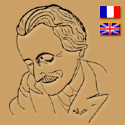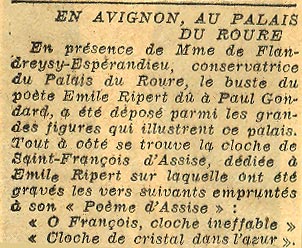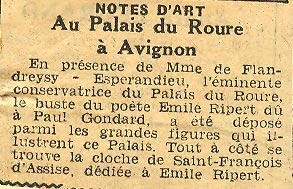![]()
ROURE Palace
| |
Music: Suite for cello BWV 1007 – Jean-Sébastien Bach (1685-1750)
Cello Concerto No.1 – III allegro molto – Joseph Haydn (1732-1827)
| LE PALAIS ROURE extracts from the manuscript “the poets that I knew”
The Roure Palace where all the archives of Provence are buried, this Provence loved for itself, but also for its kinship with Greece, Italy, Spain and with all the countries where the Spirit since Dear Roure! it seems that the spirit is concentrated more than elsewhere in this square of stones closed to outside noise, where as in the ancient house, the windows only open on the sanctuary of the family, which here is a spiritual family . Thoughts echo there wonderfully and respond to each other like the bells that hang from every door, on every staircase and sing throughout the day like metal birds. Dear Roure! To keep these image archives a frame worthy of them, which kept them in order, but also in fervor and beauty, Jeanne de Flandreysy after having bought the Palais du Roure, in the heart of Avignon, where the popes have seventy years reigned by the Spirit, restored the hotel, which threatened to ruin, of the noble family of Baroncelli. It has purified its ancestors, removed the disparate additions, restored everything to its original balance. In this framework thus restored in beauty, she knew how to bring together books, paintings, etchings, charcoals, souvenirs, engravings, autograph letters of great poets and in particular of Mistral who, thanks to her, will one day add to all her glories that of great letter-writer. Of this immense work, only Posterity will be able to give Praise to this Our Lady of the Latin archives. Dear Roure, whose real face I have seen, year after year! I hear the saws cutting stones or wood, hammers driving nails and dowels, I see the walls adorned with prestigious drawings, moving memories, shadows pass through the rooms, enveloped in their meditations, Henri de Groux, Louis le Cardonnel, Emile Espérandieu and so many others, poets, scholars, artists, all bringing something of themselves, but also carrying something, advice, comfort, a talisman, the spiritual benefit of this rigor, of this demanding discipline and of this enthusiasm too, “flame in crystal”, in the words of Louis le Cardonnel, ordered fire which illuminates without burning, when so many others burn without illuminating.
On all this country weighs a heavy history, and which did not succeed: it is here the place of a great abortion, that of an original civilization, of a nationality, which tried to constitute itself between France and Italy, which oscillated between the two, without being able to find its balance and assert its own value. Thus deprived of its culture and its language, which will survive in Felibreean works in a more literary than practical way, these people feel obscurely weighing on them the weight of an interrupted, incomplete destiny.
After the death of Emile Ripert, his statue (made by Gondard) will be deposited at the Palais du Roure in 1952
|




